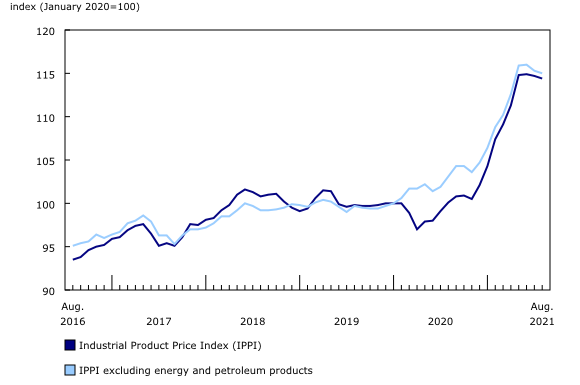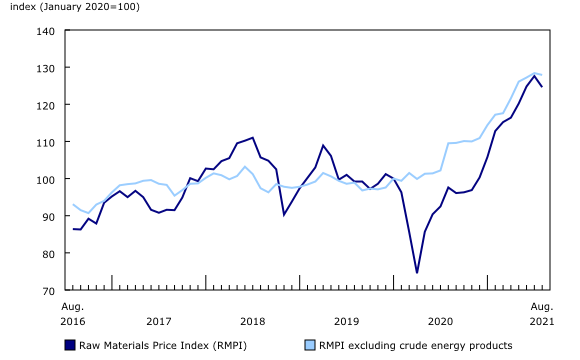Industrial product and raw materials price indexes, August 2021
Archived Content
Information identified as archived is provided for reference, research or recordkeeping purposes. It is not subject to the Government of Canada Web Standards and has not been altered or updated since it was archived. Please "contact us" to request a format other than those available.
Released: 2021-09-29
Prices for products manufactured in Canada, as measured by the Industrial Product Price Index (IPPI), declined 0.3% month over month in August, but were up 14.3% from August 2020. Prices of raw materials purchased by manufacturers operating in Canada, as measured by the Raw Materials Price Index (RMPI), decreased 2.4% month over month in August, yet increased 27.7% compared with the same month in 2020.
Industrial Product Price Index
The IPPI decreased 0.3% month over month in August. Of the 21 major commodity groups, 16 were up and 5 were down.
The decrease in the IPPI was mainly attributable to lower prices for lumber and other wood products (-14.2%). In this commodity group, the price of softwood lumber dropped 22.3%, following a record decline of 38.1% in the previous month. Compared with August 2020, softwood lumber prices fell 14.2%, the first year-over-year decline since September 2019. The abundant wood supply coupled with a slowdown in demand for construction and renovation materials is partly responsible for this decline. Excluding lumber and other wood products, the IPPI rose 0.7% in August.
Prices for primary non-ferrous metal products (-0.6%) also decreased from July, mainly because of lower prices for unwrought gold, silver and platinum group metals, and their alloys (-4.1%), which were down for a third consecutive month.
In contrast, higher prices for meat, fish and dairy products (+3.5%) and primary ferrous metal products (+3.7%) had the largest moderating effect on the decline of the IPPI.
Prices for fresh and frozen beef and veal, up 18.8% after falling 9.1% the previous month, were the primary contributors to the increase in meat, fish and dairy products. In the primary ferrous metal products group, growth was mainly due to higher prices for basic and semi-finished iron or steel products (+3.7%). Steel prices have been affected by continued high demand, limited supply and—more recently—the implementation, by China, of measures to limit production in order to meet its carbon emission targets.
Prices for chemicals and chemical products (+1.4%) continued to increase in August, driven up mainly by prices for petrochemicals (+5.4%).
The IPPI was up 14.3% year over year in August, following a 15.7% increase in July. Prices for refined petroleum energy products (including liquid biofuels; +50.1%), basic and semi-finished iron or steel products (+66.6%), and petrochemicals (+84.3%) were the primary contributors to this growth.
Raw Materials Price Index
The RMPI fell 2.4% month over month in August, its first decrease since September 2020. Of the six major commodity groups, four were up and two were down.
The decrease in the RMPI compared with July was mainly due to lower prices for crude energy products (-5.8%), particularly conventional crude oil (-6.2%), which posted its largest decline since September 2020. The decision by the Organization of the Petroleum Exporting Countries Plus (OPEC+) to increase production, coupled with uncertainty surrounding global oil demand due to a rise in the number of COVID-19 cases and the spread of the Delta variant, were the main factors affecting the decline in crude oil prices.
After five consecutive months of gains, prices for metal ores, concentrates and scrap were down 2.7% in August. In this group, prices for iron ores and concentrates (-24.2%) recorded their largest decrease since the beginning of the series in 1981. This decline was largely attributable to reduced demand for iron ore following measures implemented by China to limit production at steel mills.
Prices for crop products increased 3.4%, largely driven by higher prices for grains (except wheat; +10.1%). Prices for wheat (+5.6%) and canola (+2.1%) also contributed to the price increase for crop products. Lower projected crop yields for 2021, due to poor weather conditions in Western Canada, were largely responsible for these price increases.
Year over year, the RMPI rose 27.7%, driven up mainly by prices for conventional crude oil (+55.3%), canola (+87.2%) and hogs (+59.2%).
Note to readers
The Industrial Product Price Index (IPPI) and the Raw Materials Price Index (RMPI) are available at the Canada level only. Selected commodity groups within the IPPI are also available by region.
With each release, data for the previous six months may have been revised. The indexes are not seasonally adjusted.
The Industrial Product Price Index reflects the prices that producers in Canada receive as goods leave the plant gate. The IPPI does not reflect what the consumer pays. Unlike the Consumer Price Index, the IPPI excludes indirect taxes and all costs that occur between the time a good leaves the plant and the time the final user takes possession of the good. This includes transportation, wholesale and retail costs.
Canadian producers export many goods. They often indicate their prices in foreign currencies, especially in US dollars, and these prices are then converted into Canadian dollars. This is particularly the case for motor vehicles, pulp and paper products, and wood products. Therefore, fluctuations in the value of the Canadian dollar against its US counterpart affect the IPPI. However, the conversion to Canadian dollars reflects only how respondents provide their prices. This is not a measure that takes into account the full effect of exchange rates.
The conversion of prices received in US dollars is based on the average monthly exchange rate established by the Bank of Canada and available in Table 33-10-0163-01 (series v111666275). Monthly and annual variations in the exchange rate, as described in the release, are calculated according to the indirect quotation of the exchange rate (for example, CAN$1 = US$X).
The Raw Materials Price Index reflects the prices paid by Canadian manufacturers for key raw materials. Many of those prices are set on the world market. However, as few prices are denominated in foreign currencies, their conversion into Canadian dollars has only a minor effect on the calculation of the RMPI.
Products
Statistics Canada launched the Producer price indexes portal as part of a suite of portals for prices and price indexes. This web page provides Canadians with a single point of access to a variety of statistics and measures related to producer prices.
The video "Producer Price Indexes" is available on the Statistics Canada Training Institute web page. It provides an introduction to Statistics Canada's producer price indexes—what they are, how they are made, and what they are used for.
Next release
The industrial product and raw materials price indexes for September will be released on October 29, 2021.
Contact information
For more information, or to enquire about the concepts, methods, or data quality of this release, contact us (toll-free 1-800-263-1136; 514-283-8300; STATCAN.infostats-infostats.STATCAN@canada.ca) or Media Relations (613-951-4636; STATCAN.mediahotline-ligneinfomedias.STATCAN@canada.ca).
- Date modified:





